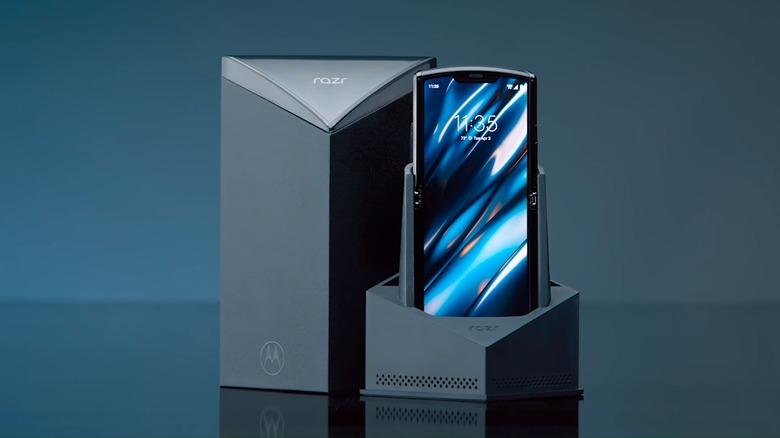Motorola's Brand New Razr Gets Torched In Early Review
When the original Motorola Razr hit the market back in 2004, the impact was immediate and pronounced. Boasting an incredibly thin design, the Razr was remarkably sleek and quickly became something of a phenomenon. The Razr would go on to become one of the best-selling mobile phones in history, though the device ultimately became nothing more than a relic once the iPhone ushered in a new era of smartphone innovation.
Fast forward to 2020 and Motorola is hoping to leverage the nostalgia associated with the Razr name with a new foldable smartphone it's calling — yes, you guessed it — the Razr.
As a longtime iPhone user, I can certainly concede that the Razr design — which folds in on itself vertically as opposed to horizontally — looks somewhat intriguing. Especially in an era where successive smartphone releases from the likes of Apple, Google, and Samsung have become iterative, I think it's nice to see some companies try and come up with something new and original.
The caveat to that, however, is that being new and original doesn't always result in a phone anybody in their right mind would want to use. Samsung's Galaxy Fold is a perfect example of that dynamic at play.
That said, is it possible that the next-gen Motorola Razr might succeed where the Galaxy Fold failed? Is it possible that the Motorola Razr will prove that there is a viable market for foldable smartphones?
Well, the early reviews would seem to indicate that the answer to that question is a resounding no. Compounding matters is that even ardent Android fans don't seem to be enamored with the device.
As a prime example, a new Motorola Razr review on DroidLife categorizes the device as "the most unpleasant phone I've used."
Right of the bat, the review notes that the Razr lacks a number of features that have all but become standard on a modern day smartphone.
The Razr has a small battery, low-resolution display, single camera without a proper set of features, and a lack of the high-end insides that power phones much cheaper. This isn't a thing people have asked for. Companies aren't making massive phones with tech-on-tech that cost $1,000 because they think people might be interested. Large phones with everything are what sell. Small phones lacking in all major smartphone feature categories with prices north of the best phones on the market, are not an idea that has proven successful. Well, that's probably because no one was foolish enough to even try it until now.
That's a harsh but fair assessment. And compounding matters is the fact that the Razr retails for $1,500. And oh yes, did we mention that it's a Verizon exclusive?
All that said, the simple reality is that the underlying appeal of the Razr is its unique form factor. Unfortunately, the Razr's foldable design leaves much to be desired as well.
You know what I realized within the first hour of owning the Motorola Razr? Unfolding a tiny phone to reveal a normal phone is not something I want to do dozens of times per day. Because the Razr isn't even easy to unfold. It's hinge is so tight (yes, it makes weird noises) that it doesn't just flick open with ease like an old flip phone might. That also means you can't easily fold it back shut without applying a good amount of pressure. This is not a one-handed foldable, even if the phone size suggests it should be. So the task of getting into the Razr isn't simple and requires effort that you may not have realized you didn't ask for until it was handed to you.
The full Razr review on DroidLife is absolutely scathing and well worth a read if you've been contemplating dropping a cool $1500 on a device that could seemingly go down in history as an epic flop.
For a somewhat opposing take, you can also check out this Razr review from CNET. It's not necessarily a glowing review, and if anything, the major positives from the device seem to center on the form factor alone.
